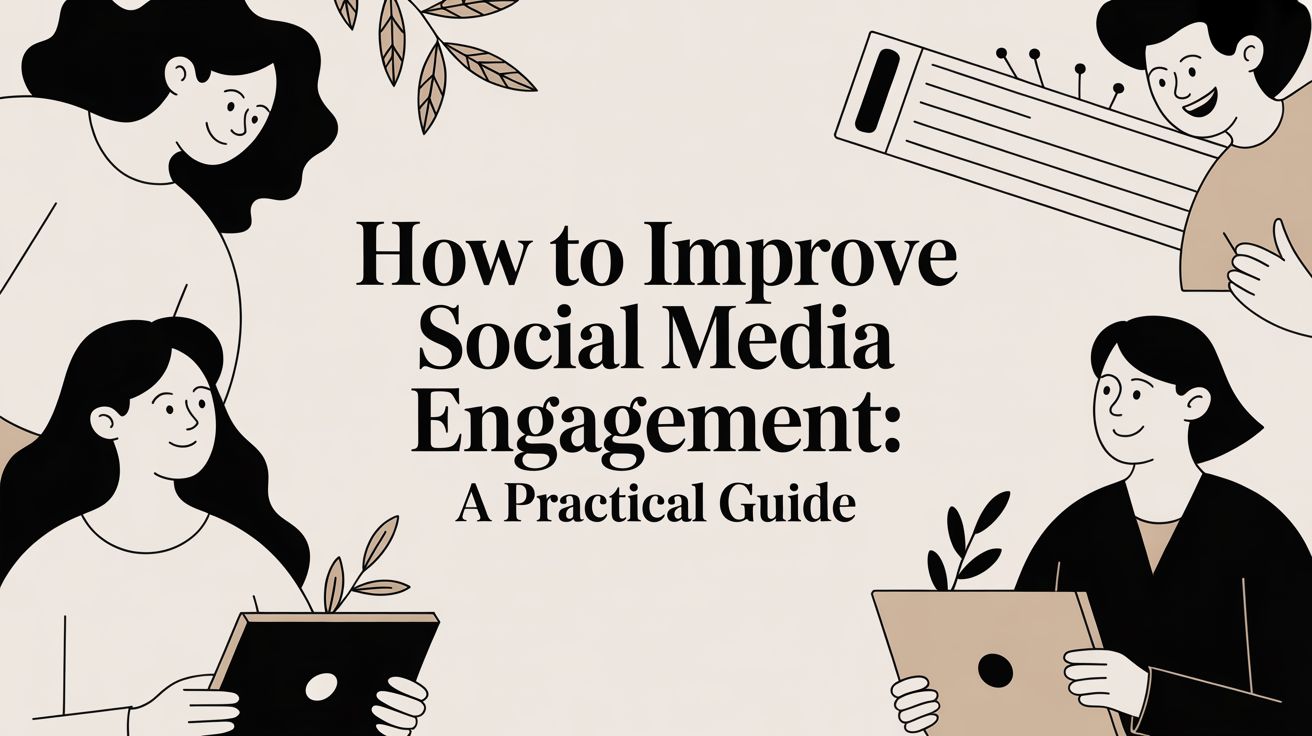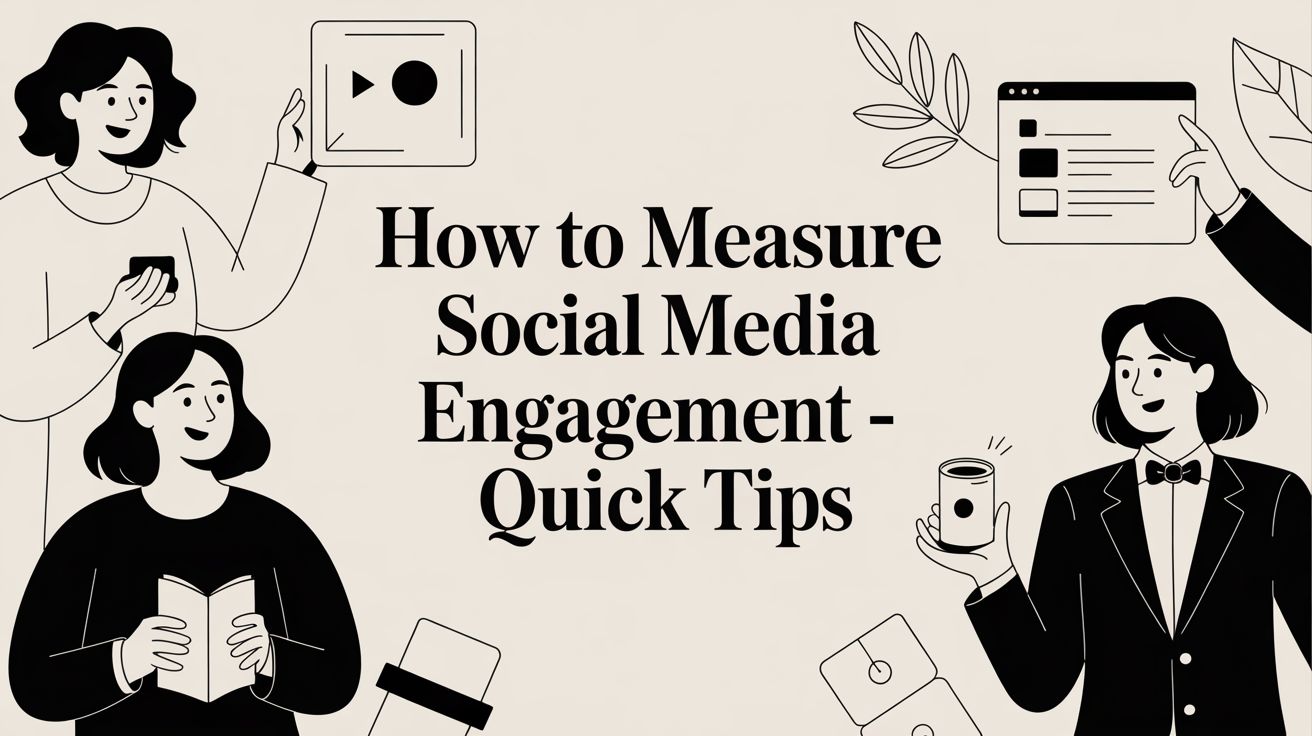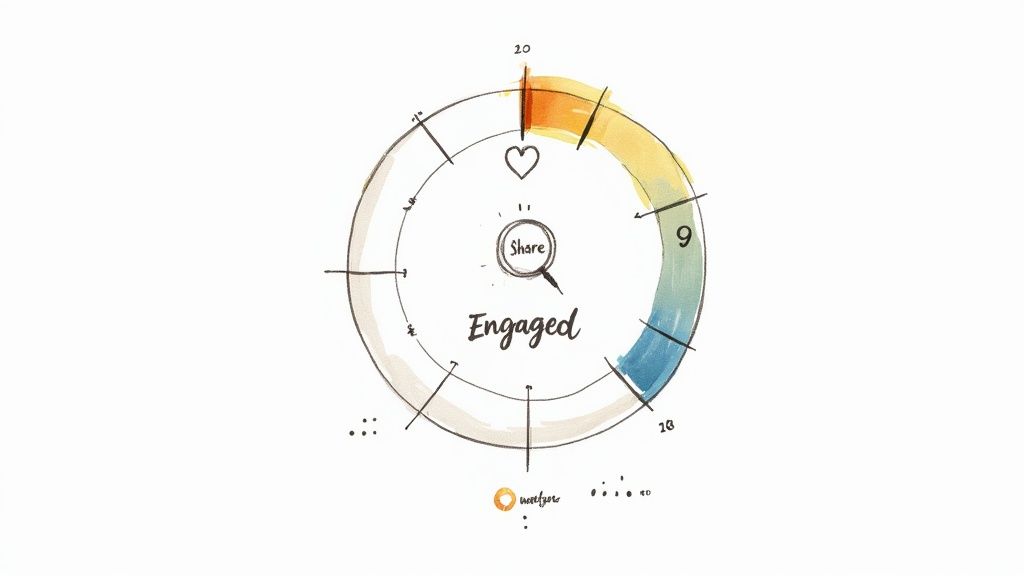Getting more engagement on social media isn't about luck or chasing fleeting trends. It all starts with a plan: create content people actually want to save and share, build a real community, and—most importantly—pay attention to your own data to see what’s working.
This isn't just about boosting likes. It's about building meaningful connections that lead to real business results.
Defining Your Engagement Strategy
Before you can get more engagement, you have to define what "engagement" actually means for your brand. It’s so easy to get caught up in vanity metrics like follower counts, but those numbers rarely tell the full story.
Real engagement is about the quality of the interaction, not just the quantity. It’s what builds a loyal community and pushes your business goals forward. So, instead of obsessing over likes, let's shift the focus to actions that signal genuine interest and loyalty.
Moving Beyond Surface-Level Metrics
To make this practical, you need to zero in on the metrics that truly matter. These are the actions that require a little more effort from your audience and show they’re paying attention.
- Saves: When someone saves your post, they're bookmarking it for later. It’s a huge signal that your content is valuable and useful. Practical Example: A personal trainer's post with a "5-Minute Ab Workout" video gets a high number of saves because people want to come back to it later.
- Shares: A share is a personal endorsement. Someone is putting their own reputation on the line to recommend your content to their friends and followers. Practical Example: A visually appealing infographic on "10 Ways to Reduce Plastic Waste" is highly shareable because it's valuable and makes the sharer look knowledgeable.
- Meaningful Comments: A thoughtful comment—one that asks a question, shares an opinion, or tags a friend—sparks a real conversation. Practical Example: A post asking "What's the best career advice you've ever received?" prompts detailed, personal stories, not just one-word replies.
The goal isn't just to be seen; it's to be remembered and valued. Shifting your focus from likes to saves and shares transforms your content from a fleeting impression into a lasting resource for your audience.
Before you can improve, you need to know where you stand. It's time to dig into your metrics to see what’s actually connecting with your audience and what's falling flat.
Engagement Metrics That Actually Matter
This table breaks down the metrics that offer real insight into your performance and how they tie back to what you’re trying to achieve.
| Metric | What It Measures | Business Impact Example |
|---|---|---|
| Saves | The number of users who saved your post to a private collection. | A high number of saves on a "how-to" guide indicates your audience finds your content useful, positioning you as an expert and building trust for future sales. |
| Shares | The number of times your content was shared to other users' stories, feeds, or messages. | High share counts on a brand story video can dramatically increase brand awareness and attract new followers who align with your values. |
| Comments | The number of direct replies to your post (focus on quality over quantity). | A post asking for customer feedback that receives detailed comments can provide valuable insights for product development and improve customer loyalty. |
| Link Clicks | The number of users who clicked a link in your bio, post, or story. | For an e-commerce brand, a high click-through rate on a story with a product link directly correlates to website traffic and potential sales. |
Focusing on these metrics gives you a much clearer picture of what your audience cares about, which is the foundation for any successful content strategy.
Auditing Your Current Performance
Okay, time for a quick, productive engagement audit. You can't improve what you don't measure. Just pull your analytics from the last 30-60 days on whatever platform you use most, whether it's Instagram, TikTok, or LinkedIn.
Productive Workflow:
- Block 30 minutes: Put it on your calendar. Don't let other tasks get in the way.
- Go to your platform's analytics: On Instagram, head to your Professional Dashboard and look at your Content Interactions.
- Identify top 3 posts for Saves & Shares: Don't get distracted by likes. Make a quick note of which posts got the most of these two key metrics.
- Ask "Why?": You might find a behind-the-scenes carousel got twice as many saves as your polished product shots. That’s a huge clue! It tells you your audience is hungry for authenticity.
To get a more complete picture of how to approach this, check out our guide on what is social media engagement.
Setting Purposeful Engagement Goals
Once you know what's working, you can set clear, achievable goals that actually connect to your business. Ditch the vague "I want more engagement" and get specific.
Here’s what that looks like in practice:
- If your goal is brand awareness: Aim to increase shares by 15% next quarter by creating more infographics or relatable memes.
- If your goal is lead generation: Focus on bumping up link clicks by 20% by adding stronger, clearer calls-to-action (CTAs) in your captions and Stories. Practical Example: Change "Link in bio" to "Get your free guide to time management at the link in our bio."
- If your goal is community building: Set a target to increase meaningful comments by 25% by asking more open-ended questions.
When you define what success looks like and know your starting point, every piece of content you create has a purpose. For a fantastic real-world example, see how one design agency drastically increased Facebook engagement simply by getting strategic with their content.
Creating Video Content That Captures Attention
Let's be honest: video isn't just a "type" of content anymore. On social media, it's the main event. If you want to stop the scroll, get people talking, and build a brand that people actually remember, you have to get good at video. It’s simply non-negotiable.
Don't just take my word for it. Consumers overwhelmingly prefer to learn about new products through short-form video. Marketers are all-in, with 93% of them planning to pour more resources into social marketing, and a huge chunk of that is going straight to video.
The numbers back this up. TikTok's average engagement rate can hit a staggering 7.5% for smaller creators. That completely blows Instagram’s 0.50% and Facebook’s 0.15% out of the water. If you're curious, Sprout Social's full report has a ton of great data on this.
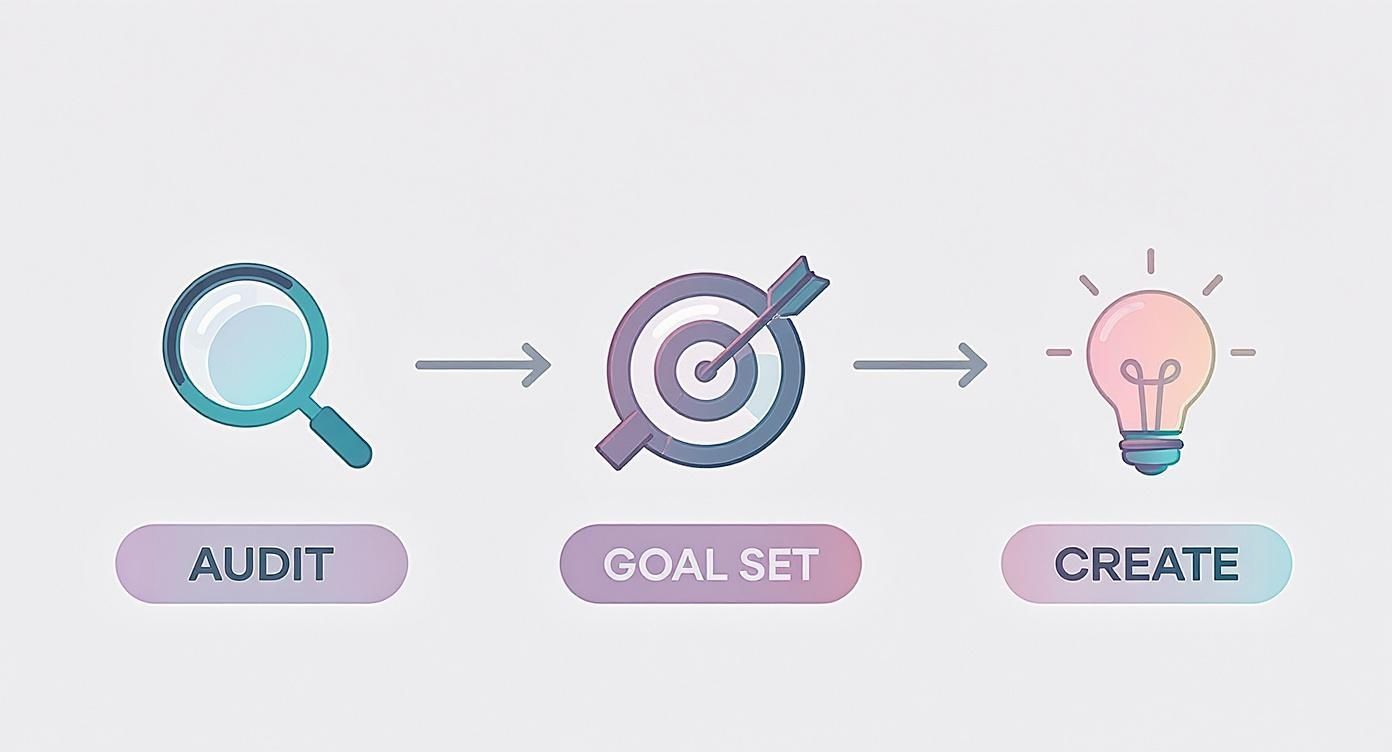
This simple flow chart really drives the point home. Great content isn't just something you create on a whim. It’s the final, crucial step that’s built on a solid foundation of understanding your performance and knowing what you’re trying to achieve.
Mastering the First Three Seconds
The single most important part of your video is the opening. You have about three seconds to give someone a reason to stop their thumb and watch. If your hook misses, nothing else matters.
A great hook usually does one of three things:
- Sparks Curiosity: Start with a question or a bold statement. Practical Example: A financial advisor could lead with, "This is the single worst money mistake you can make in your 20s."
- Promises Value: Tell them exactly what they're going to get. Practical Example: A productivity coach might say, "Here’s how to get five hours back every week with one simple change." The benefit is crystal clear.
- Shows Action: Ditch the slow intro and jump right into the most interesting part. Practical Example: A chef doesn't need to show a pile of ingredients—they should start with the satisfying sizzle of food hitting a hot pan.
The secret to a great hook isn't being loud; it's about being clear and compelling. Promise a solution, an answer, or a story, and you'll earn their attention.
Once you have them, deliver on that promise quickly. If you need some more inspiration, our guide on social media content ideas is packed with concepts you can easily adapt for video.
Choosing the Right Platform for Your Videos
Where you post your video is just as important as what's in it. Every platform has its own vibe, its own culture, and its own audience expectations. A "one-size-fits-all" video strategy is a recipe for failure.
Here’s a quick cheat sheet to help you think about where your videos belong:
| Platform | Best For | Content Style |
|---|---|---|
| TikTok | Raw authenticity, trends, and pure entertainment. | Lo-fi, personality-first content is king. Think behind-the-scenes, relatable humor, and jumping on whatever sound is trending that day. |
| Instagram Reels | Aesthetically pleasing, educational, and inspirational stuff. | Polished, high-quality visuals do best here. How-to guides, quick tutorials, and aspirational lifestyle content crush it on Reels. |
| YouTube Shorts | Quick educational bits, previews, and repurposed clips. | Fast, value-packed, informative videos. It's a fantastic spot for sharing highlights from longer videos or answering a single, specific question. |
Practical Example: A boutique coffee shop could use TikTok for a funny clip of a barista’s daily blooper, Instagram Reels for a gorgeous tutorial on latte art, and YouTube Shorts for a 30-second rundown on different coffee bean origins. Same brand, but a smart strategy that plays to each platform’s strengths.
An Efficient Workflow for Creating Short-Form Video
Creating video consistently doesn't have to be exhausting. You don't need a fancy studio—your smartphone and a good plan are all you really need.
Here’s a simple workflow to boost your productivity:
- Batch Your Ideas: Set aside one hour a week for brainstorming. Use a simple tool like Google Keep or Notion. Focus on common questions people ask or problems you can solve. For example, a real estate agent could list ideas like "3 Red Flags to Look for During a Home Tour" and "Common First-Time Homebuyer Mistakes."
- Script Just the Hook: For each idea, write only the first line. The hook is the most creative part, so give it your full attention. The rest can be more off-the-cuff.
- Film in Batches: Find a two-hour block to film several videos at once. This is a game-changer. It saves a ton of time on setup. Just change your shirt or background to keep things looking fresh.
- Edit on Your Phone: Use apps like CapCut or InShot. They're powerful and easy to learn. Productivity Tip: Create a template for your brand's font and color for captions to speed up editing. Always add captions (most people watch without sound!), trim out dead air, and add trending audio right in the app.
This approach helps you stay consistent without burning out, which is the key to winning with video.
Transforming Followers Into a Thriving Community
Let’s be honest: a huge follower count looks great on paper, but it doesn't always translate to a healthy brand. The real magic happens when you turn those passive followers into an active, engaged community. This is where you shift from just broadcasting updates to actually starting conversations.
True community is built one interaction at a time. It’s all about making individual followers feel seen, heard, and genuinely valued. When people feel like they're part of something real, they're far more likely to jump into the comments and become your biggest advocates.
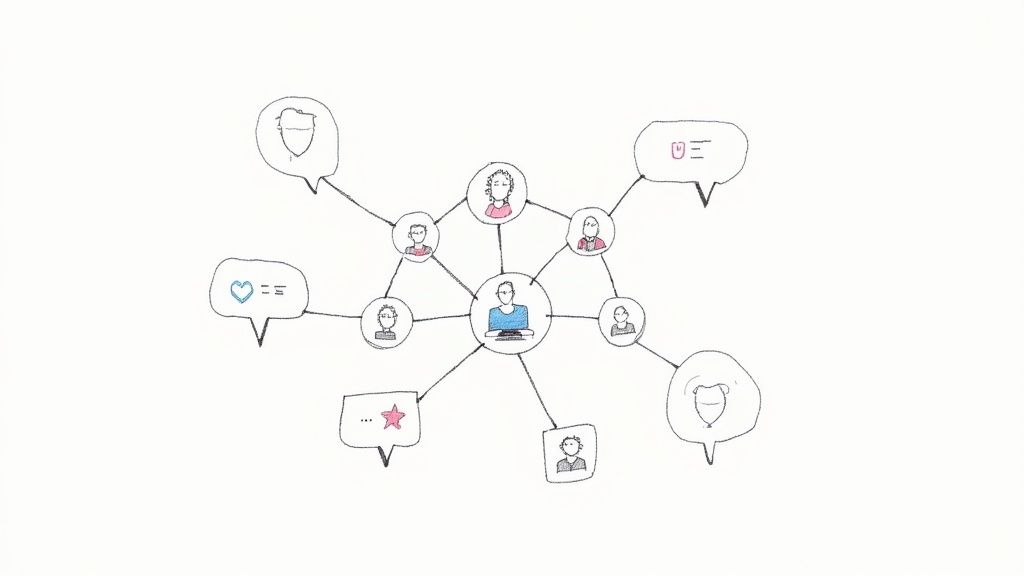
Write Captions That Start Conversations
The single biggest mistake brands make is writing captions that talk at their audience instead of with them. Think of your caption as the first line of a potential conversation. The trick is to ask smart, open-ended questions.
Ditch the generic "What do you think?" and get more personal.
- Instead of: "Here's our new coffee blend. What do you think?"
- Try: "What's the one morning ritual you can't live without? For us, it’s that first sip of coffee before touching any emails."
See the difference? This simple tweak invites people to share personal stories and creates a genuine connection. You want to make your followers pause and reflect, making them far more likely to share their own experiences. This approach is fundamental to learning how to increase social media engagement because it puts dialogue over monologue.
Master the Art of the Reply
How you handle comments and DMs is just as important as the content you post. A quick, thoughtful reply can turn a casual commenter into a die-hard fan. Your response game should be built on speed and substance.
A fast reply shows you’re paying attention. But a generic "Thanks!" falls flat. To make followers feel truly heard, your responses need to add something to the conversation.
Responding to comments isn't a chore; it's an opportunity. Each reply reinforces that there's a real person behind the account who cares about the community. This simple act is one of the most powerful loyalty-building tools you have.
Here’s a practical workflow for managing responses:
- Set aside 15 minutes twice a day: One block in the morning, one in the afternoon. This prevents you from being constantly pulled into notifications.
- Follow this reply formula: Acknowledge their point ("That's a great question"), add value or ask a follow-up ("Have you ever tried…?"), and use their name.
- Create canned responses for FAQs: Use your phone's text replacement feature for common questions (e.g., "Where are you located?"). This saves time, allowing you to focus on crafting more personal replies for unique comments.
Practical Example: If someone comments, "I love this color!" don't just "like" it. Reply with, "So glad you think so, [username]! We were actually inspired by a sunset we saw last month. Does it remind you of anything?" This deepens the connection.
Harness the Power of User-Generated Content
User-generated content (UGC) is the ultimate form of social proof. When your followers post about your brand, they're giving you an authentic stamp of approval. Featuring their content shows you value their contributions and builds a powerful sense of belonging.
Getting UGC doesn't have to be complicated. Start by creating a branded hashtag and putting it in your bio.
Here's a simple workflow for sourcing and sharing UGC:
- Monitor Your Hashtag and Tags: Use a tool like TweetDeck or your platform's native search to create a dedicated column for your hashtag. Check it once a day.
- Always Ask for Permission: Before you repost, send a DM. Productivity Tip: Create a template message: "Hi [username]! We absolutely love this post. Would you mind if we featured it on our page with full credit to you? Thank you!"
- Give Proper Credit: When you share, always tag the creator prominently in both the caption and the image itself. It gives them exposure and shows genuine appreciation.
By consistently celebrating your community's creativity, you’ll get a steady stream of authentic content and strengthen the bond with your most passionate followers.
Using Analytics to Sharpen Your Content Strategy
Stop guessing what your audience wants. The secret to consistently high engagement isn't cracking some viral code; it's listening to the data your audience is already giving you.
Think of your analytics as a roadmap. It shows you exactly where to go next. Every major platform—Instagram, TikTok, Facebook—gives you a free suite of tools packed with these insights. The trick is to look past the easy numbers and dig into the metrics that show what people truly care about.
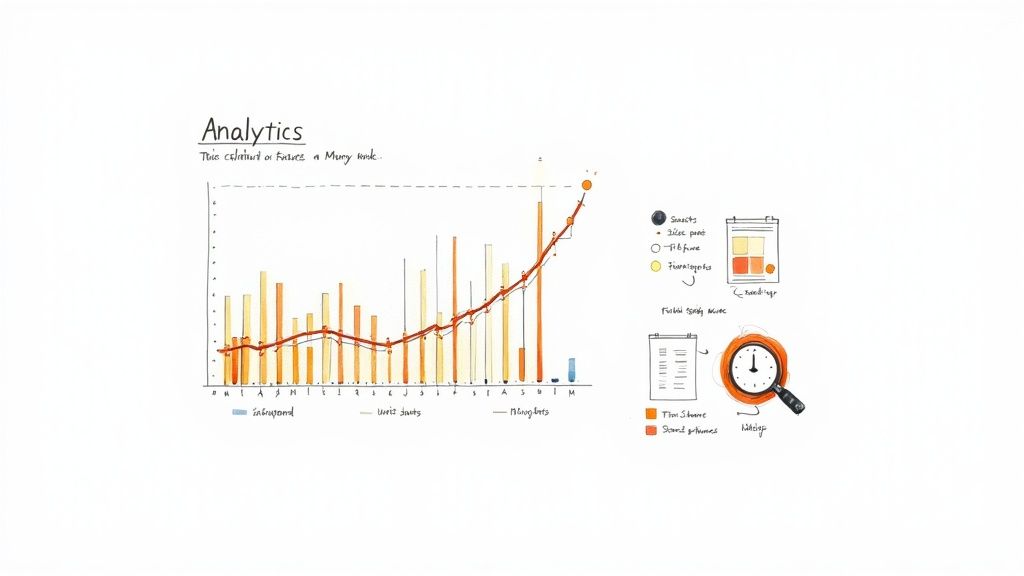
Pinpoint Your Highest-Performing Content
First, find your winners. Hop into your Instagram Insights or TikTok Analytics and look for the posts with the highest number of shares and saves. These metrics are gold. They tell you your content was so good that someone went out of their way to keep it for themselves or pass it along.
Practical Example: You're a graphic designer, and you notice a simple carousel post explaining "3 Free Fonts You Need" got 5x more saves than your portfolio pieces. That’s a huge clue. It means your audience is craving practical, educational content they can use.
Once you find a high-performer, dissect it:
- Format? Was it a Carousel, a Reel, a static image?
- Topic? Was it educational, behind-the-scenes, or inspirational?
- The Hook? What did the first sentence or the first three seconds of the video say?
This analysis helps you build a repeatable framework.
Find Your Audience’s Prime Time
Posting when your audience is scrolling gives your content an algorithmic head start. Your native analytics will show you the exact days and hours your followers are most active.
Go to the "Audience" or "Followers" tab in your analytics. You'll see a chart mapping out activity. If there's a huge spike on Tuesdays at 7 PM, that’s your golden hour. Productivity Tip: Use a scheduling tool (like Meta Business Suite, which is free) to plan your posts for these peak times automatically.
Your best posting time is unique to your audience. General best-practice guides are a good starting point, but your own data is the ultimate source of truth.
Conduct a Monthly Performance Review
Consistency isn't just about posting; it's about reviewing. Block out one hour at the end of each month for a quick performance check-in. To make sure your content is actually landing, you need to know how to measure social media engagement effectively.
Here’s a straightforward monthly workflow:
- Identify Top 3 Posts: Find the three posts with the most shares, saves, and comments.
- Identify Bottom 3 Posts: Do the same for your three lowest-performing posts.
- Spot the Patterns: Lay the two lists side-by-side in a simple document. What separates the winners from the duds? Practical Example: "The winning posts were all carousels with a 'how-to' format. The duds were generic promotional images."
- Set an Actionable Goal: Based on what you found, set one simple goal for the next month. Something like, "Create two more educational carousels based on our top post from this month."
This ritual creates a powerful feedback loop, ensuring you’re refining your strategy based on what your audience actually wants.
If you really want to get into the weeds on the formulas and calculations behind the numbers, our guide on how to measure social media engagement breaks it all down.
Connecting with Audiences on a Deeper Level
If you really want to boost your engagement, your content needs to do more than just exist—it has to connect. That means ditching generic posts and creating content that feels personal and genuinely relevant to the people you're trying to reach. A one-size-fits-all approach is the fastest way to get ignored.
The real key is understanding the unique cultural nuances and local trends that matter to your audience. This isn't about being opportunistic; it’s about showing you’ve done your homework.
Speak the Local Language
Connecting with a local audience is all about weaving their world into your content. This goes way beyond just name-dropping a city. It's about tapping into local events, inside jokes, and cultural touchstones that make your brand feel like a neighbor.
Practical Example: A coffee shop in Austin, Texas, could post about the best local breakfast tacos to pair with their cold brew. This shows they get the local culture (breakfast tacos are a huge deal in Austin) and offers immediate, localized value.
Here's a productive workflow for this:
- Scout Local Hashtags and Geotags: Spend 15 minutes a week using your platform’s search tools to see what people are talking about in your target area. What topics, events, and places are trending?
- Follow Local Influencers and News Outlets: These accounts are a goldmine for real-time local info. Watch what they’re covering and how their audience is reacting.
- Use Local Lingo (Carefully): If there’s a common local phrase, using it correctly can build instant rapport. Just make sure you get the context right.
This localized approach makes your content feel like it was made just for them.
The most engaging content feels like it was created just for the person seeing it. When you speak to a community's shared experiences, you're not just a brand; you're part of the conversation.
Navigating Global Audiences with Finesse
For brands with a global footprint, the challenge gets a lot bigger. What works in one country might fall completely flat in another. The answer isn't to create one watered-down message, but to adapt your core message for each key region.
With over 65% of the global population now on social media, understanding these regional differences is non-negotiable. Engagement rates vary wildly across the globe, often because savvy brands have mastered creating localized content. You can discover more about these global social media trends and how they affect engagement.
Take a global sportswear brand, for example. They wouldn't just blast the same ad everywhere.
- In Brazil: Their content might center on soccer, community, and vibrant street culture.
- In Japan: The focus could shift to precision, discipline, and the blend of technology with performance.
- In Canada: They might lean into winter sports and the country's rugged, natural landscapes.
The product is the same, but the emotional and cultural frame is entirely different. It shows respect for local identity and massively boosts the odds that your content will connect.
Connecting with Gen Z and Generational Shifts
Different generations use social media in fundamentally different ways, and no group has rewritten the rules more than Gen Z. This audience demands authenticity, values transparency, and has zero tolerance for anything that feels like a traditional ad.
Data shows that 56% of Gen Z find social media content more relevant than old-school media. To reach them, you have to speak their language, which often means a more unpolished, personality-driven style.
Here’s how to adapt your content for a younger crowd:
- Embrace Lo-Fi Video: Highly produced, glossy videos can feel distant. Practical Example: A skincare brand could show a real employee doing their morning routine in their actual bathroom, rather than a perfectly lit studio shot with a model.
- Use Humor and Memes: Meme culture is the lingua franca of Gen Z. Jumping on relevant trends shows your brand is culturally plugged-in.
- Prioritize Purpose: This generation cares about social and environmental issues. Practical Example: A clothing brand could post a Reel showing their process for using recycled materials, connecting their product to a larger mission.
By understanding these generational nuances, you can build a more dynamic and effective content strategy that not only knows how to increase social media engagement but also creates real, lasting brand loyalty.
Common Questions About Social Media Engagement
Even with a solid plan, the day-to-day of managing social media throws up a ton of questions. Let's walk through some of the most common ones.
Think of this as your field guide for those "am I doing this right?" moments.
How Long Does It Take to See an Increase in Engagement?
This is the big one, and the honest answer is: it depends. But if you’re consistent, you should start seeing the first green shoots within 4-6 weeks. This isn’t about going viral; it's the small stuff—more comments, a few more shares, a bump in saves. These are the early signs that you’re on the right track.
Real, sustainable growth usually takes longer, somewhere in the 3-6 month range. That's the time it takes to build trust, learn what your audience actually wants, and get into a rhythm. It’s a slow burn, not a firework.
The key is consistency over intensity. Showing up regularly with valuable content is far more effective than sporadic viral attempts, which rarely build lasting community.
This gradual build-up means you're attracting the right people—an audience that’s actually interested in what you have to say.
Should I Post Every Day to Increase Engagement?
Nope. In fact, this is one of the fastest routes to burnout and, ironically, worse engagement. This is a classic case where quality and consistency trump sheer quantity.
Posting three genuinely valuable posts a week will always beat seven low-effort, "just-to-post-something" updates.
Here’s a productive workflow to find your sweet spot:
- Check your analytics. Your data will tell you when your audience is online and which posts are hitting the mark.
- Run simple experiments. Try a Monday-Wednesday-Friday schedule for a month. Note the results in a simple spreadsheet. The next month, try Tuesday and Thursday. See what the data says.
- Prioritize value, always. It’s better to be a reliable source of great content than a constant source of mediocre noise.
Find a rhythm you can stick with for the long haul. That's how you build a presence that lasts.
What Are Some Common Mistakes That Kill Engagement?
It's often the small, unintentional habits that slowly drain your engagement. Knowing what they are is half the battle.
The single biggest mistake? Broadcasting instead of communicating. This turns your feed into a one-way megaphone. Practical Example: Only posting product photos with prices versus asking your audience how they use your products in their daily lives.
Another huge one is ignoring comments and DMs. When someone takes the time to reach out, silence is the worst possible response. It signals that you don't care.
Other quiet engagement killers include:
- Using irrelevant or spammy hashtags. A wall of 30 hashtags doesn't help. It just looks desperate. Stick to 5-10 highly relevant tags.
- Forgetting to adapt content for each platform. Practical Example: Posting a text-heavy graphic designed for LinkedIn directly to Instagram Stories where it will be unreadable and ignored.
- Being wildly inconsistent. Vanishing for two weeks and then spamming five posts in an hour just confuses your followers and the algorithm.
The fix for all of these is simple: focus on the two-way conversation, pack value into every post, and show up as a reliable, authentic voice in your community's feed.
Ready to stop guessing and start growing? Postful is the AI-powered tool built for founders and creators who need to show up consistently without the grind. Get curated post ideas, on-demand brainstorming, and automated workflows that make creating engaging content simple. Join the waitlist at https://postful.ai and build a social media presence that works for you.

